 |

The Robot series was introduced in 1935 by Otto Berning & Co., which was based in Schwelm, former West Germany, not far from Cologne. The Robots were a range of cameras with spring-wound motors so one could take many photos consecutively at high speed with winding the camera only once. It had a rotary shutter, unusual to find in still cameras but common in movie cameras, which usually also featured spring motors. The Robots had interchangeable lenses with a 26mm screw mount, until the introduction of the Robot Royal rangefinder models, which used a bayonet mount. Most Robots used 135 film and had a square 24x24mm format. A variety of cassettes was needed for film supply and uptake, only later models (from the Robot IIa onwards) used standard 135 film cassettes and featured rewind knobs.
Berning Robot I
The Robot I was invented by Henri Killfit, who received further fame after WWII for the Kilfitt macro lenses and the Mecaflex miniature SLR, amongst others. Three different lenses were available, a 30mm Carl Zeiss Tessar with f/2.8 or f/3.5 aperture, or an f/3.5 Meyer Primotar. A Schneider 50mm f/5.5 Telexenar represented the telelens range. Remember, due to the smaller square format the focal length of the lenses was shorter than those of equivalent full-frame lenses.
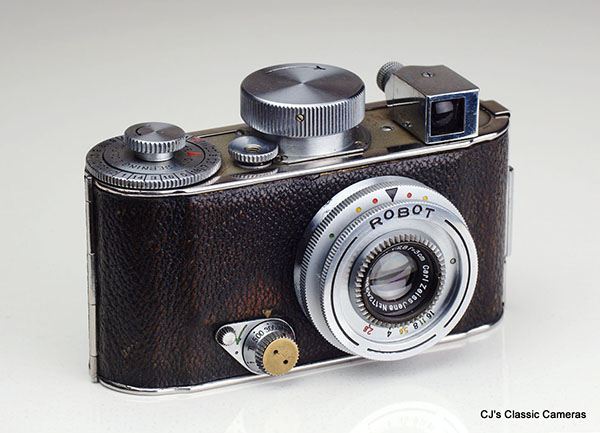
A 1935 Robot I with interchangeable Carl Zeiss Jena Tessar 30mm f/2.8 lens. The speed knob next to the lens also had a lever used to swivel a built-in yellow filter behind the lens. This example is somewhere mid-production, earlier production had somewhat smaller windknobs and a slightly different viewfinder, whereas later production had an extra ring at the base of the central wind knob which functioned as a shutter lock (see below).
 | |
The Robots were often called spy cameras, as they were small and could be concealed after winding up, making photos without the need of winding after each frame. The Robot I could also 'peek around the corner' by swivelling the viewfinder 90 degrees, as shown here. In this mode the viewfinder showed a blue filter, which gave a better impression of the dark-light contrast of the scene for black and white photography.
|
As to the name Robot, I am not quite sure that in the early 1930s one thought of robots the same way as we do now, but the advertising brochures did show a robot-like creature. Perhaps these were wind-up toys that could walk by themselves? I can only assume that the camera was named that way because of its similar automatic features and needed winding up.

A later version of the Robot I with a ring to block the shutter so it couldn't accidentally be fired. There's a flash sync above the speed knob, but this is probably a later addition. Also shown is a Robot I cassette, which differed from those of later Robot models. Like the Robot I above, this one also has a Carl Zeiss Jena Tessar lens, but with a slightly longer focal length of 32.5 mm. I am not sure if there was a real difference or that the new number more accurately reflected the actual focal length of the lens.
Berning Robot II
The 1938 Robot II was the second model and formed the base of many subsequent models until the redesigned Royal rangefinder models. It was small, robust camera with a build-in double viewfinder with eyepieces at the rear and side of the camera. It used two separate cassettes for film supply and uptake, labelled T and N cassettes, respectively. Although the cassettes made using the camera a little tedious, they were cleverly designed, as they would slightly open to make film transport possible only when the camera back was closed. Hence, accidentally opening the camera with film loaded would only spoil a small bit of film, but not the film inside the cassettes.

A 1947 Robot II with Schneider 40mm f/1.9 Xenon lens and yellow filter attached. This example is a late version with accessory shoe and small flash sync socket.
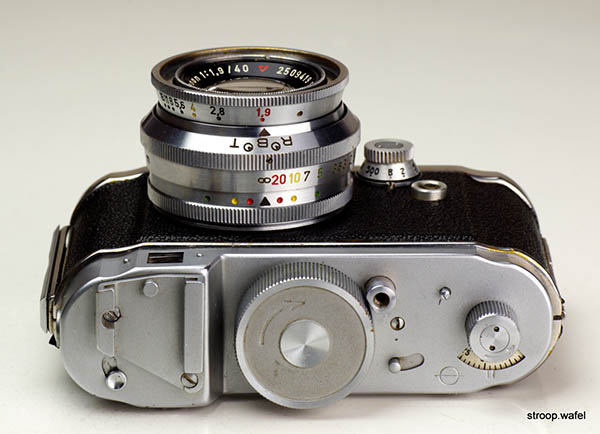
Top view of a Robot II showing the large round motor wind knob. Also note the coloured lens markings, which aided finding the right aperture for the desired depth of field from close range to infinity.
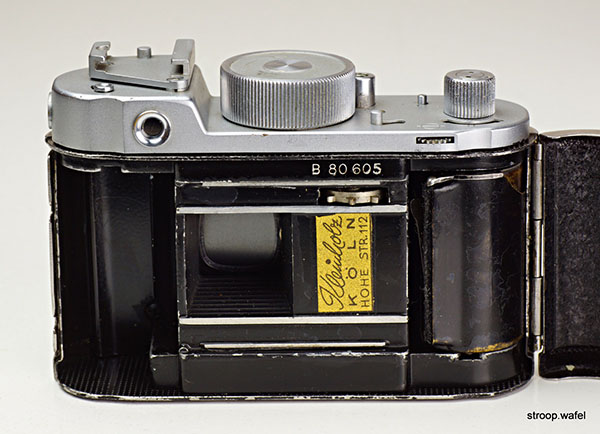
Rear view of a Robot II showing the fairly small film gate (25x25mm according information on the web but really only 23x23mm). On the right the 'N' uptake cassette is present, on the left the 'T' supply cassette is missing. Standard 135 film cassettes do not fit the Robot II, neither do the later TR and NR cassettes (as I learned the hard way).
A rather rare black Robot II was also produced, in fact in at least two different varieties. One version had a larger wind knob which allowed up to fifty photos for one wind cycle, this model was used by the German airforce (Luftwaffe) and had serial numbers starting with an F, e.g., F50039-6. Another version was identical to regular Robot II but with black painted top and bottom plates and often a black wind knob. They had regular Robot II serial numbers, five digits preceded by a letter B, but often had a single digit suffix of which the meaning is not clear to me. They came most commonly with a CZJ Tessar lens marked f=3 cm, which is an updated version of the Tessar found on the Robot I.
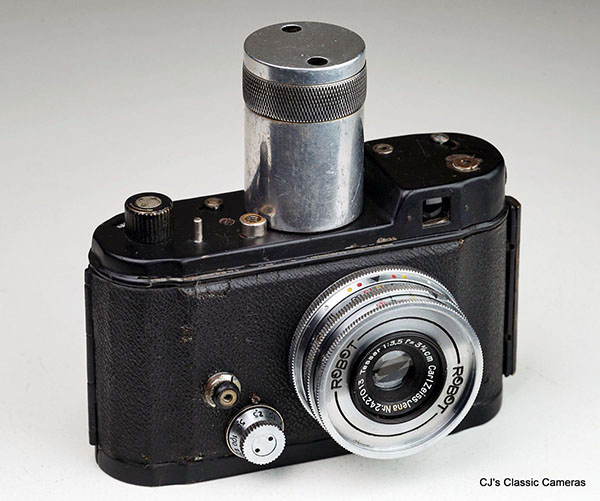
Black version of the Robot II with uncoated Carl Zeiss Tessar 37.5mm f/3.5 lens and double-sized spring windknob. Based on the serial number of the lens, this Robot appears to be an early pre-war version of around 1938. The camera looks like it has been partially repainted, but it was probably black originally.
The Tessar on this Robot was a great little lens, it even had click stops on the focus ring so one could focus the lens without taking your eye off the viewfinder, once you memorised where the click stops were. This camera was truly build for speed.

This is a genuine black Luftwaffen Robot II. It is marked 'Luftwaffen Eigentum' on the back (see photo below) and has serial number F48123-6. It is shown with the Carl Zeiss Jena Biotar 40mm f/2 lens it came with.
(left) The Luftwaffen Robot is most commonly found with a black 75 mm telelens, which is the configuration in which these Robots were mounted in German WWII fighter planes. It can also be found with a Carl Zeiss Biotar, as is the case here. I haven't been able to find out what these configuarations were used for specifically. Like the camera (as can be seen on the picture on the right), the lens is also marked Luftwaffen-Eigentum. (right) Rear view of the Luftwaffen Robot. Hard to see unless you click on the photo to enlarge is in the 'Luftwatten-Eigentum' engraving at the back, on the narrow edge of the top housing just above the film chamber. On repurposed Luftwaffen Robots these markings were often filed away or filled with paint.
Berning also produced a range of interesting accessories for the Robot range. One of these was the rangefinder attachment, designed to turn your Robot into a rangefinder camera before Robot actually made one. It had a feeler that would sit against the front ring of the lens, which went back and forth during focussing. I didn't expect much of it, as I thought that contrast would be pretty poor considering that the mechanism is not shielded from external light, but I was pleasantly surprised how useable it turned out to be.

Robot II with rangefinder attachment. It has three different settings for different focal length lenses, but it doesn't fit my Schneider 40mm Xenon lens, so I suspect it was meant for the Carl Zeiss Biotar 40mm instead. Also note this is an earlier version of the Robot II than the one shown above first, but later than the black one above, as it has the 'new' wind knob but lacks the accessory shoe. It also has a strange flash sync nipple.

| |
Top view of the rangefinder attachment showing how it 'senses' the focus of the lens.
|
Berning Robot Star
The Robot II was followed up by the Robot IIa, which was the first Robot that could be used with a regular 35mm film cassette. However, it still needed a Robot uptake cassette. The next model, the Robot Star, was the first model with a rewind lever. Even though it also still used a dedicated uptake cassette, it had the option of rewinding the film back into the 135 film cassette. Other than that there was very little change with the earlier Robot II and IIa besides some small internal changes to the motor wind mechanism and the addition of an extra flash sync socket for electronic flash.
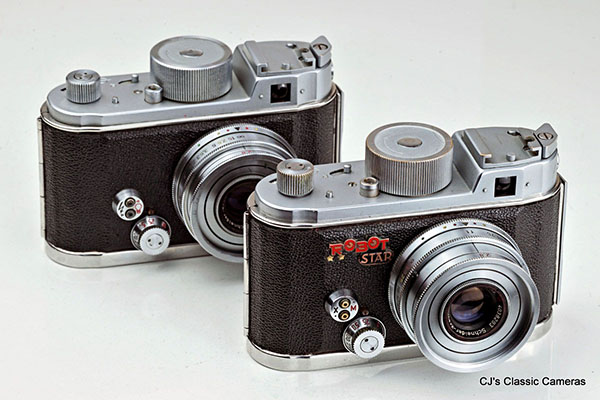
A pair of Robot Stars, both with Schneider-Kreuznach Xenar 38mm f/2.8 lens. The one at the back was sold to me as a Robot IIa, and you may have looked at it thinking, that's not a Star. Indeed, it is not marked as such, but it is virtually identical to the one in front, except for the Robot Star logo. It has in fact a higher serial#. I have seen a few of this type without Star logo on the internet, and it has been suggested that the logo simply may have fallen off, but one would expect to see some sort of mark. Perhaps Robot stopped branding this model as Star when their next Star model (shown further down) came out?
Berning Robot Star II Vollautomat 'no name'
This new model with quite a mouthful of a name was introduced to replace the earlier Robot Star (shown above). The Vollautmat was mostly a cosmetic upgrade. Gone was the large springwind knob on the top, it was replaced by a plastic wheel on the side of the camera. A new brightline viewfinder with frames for 40 and 75mm lenses was introduced at the expense of the 90 degree angle finder typical of earlier Robots. The flash sync and shutter speed selector knob were kept the same though. Also the inside of the camera looked very much the same to earlier models. Since all the changes appear to be limited to the top part of the camera I gather therefore that the shutter mechanism was essentially the same, but I have opened the camera far enough to confirm this. It does apear that the body was diecast and therefore stonger and more uniform that earlier models. It was still a very heavy camera for its size.

Robot Star II Vollautomat with the same Xenon lens as mounted on the Robot II above, as I got this example as body only. I am not sure what the standard lens for this model was, on various examples on the internet anything goes and I have rarely seen one with an age-correct (early 60s) lens.
This example is a bit peculiar as it has no name plate at the front next to the viewfinder like most other Star IIs. I have seen several more, so it appears to be a regular production version, but I have not been able to find any info about it.
The name 'Vollautomat' is a misnomer, there was nothing automatic about this camera other than of course the film transport and shutter cocking, just like all earlier models. This is actually the second version of this model, the first version still had the springmotor wind knob at the top, and was available in two versions, a 25-shot and a 50-shot version, the latter with double-extended wind knob. I have not been able to find out if the later version shown below was also available in two 'sizes'.
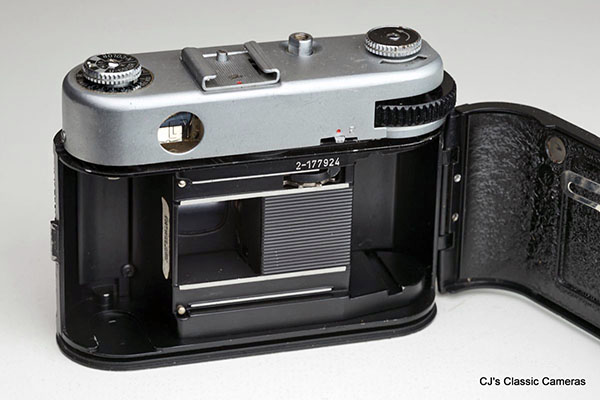
Rear view of the Star II showing the film compartment. You will noticed it had no take-up spool, it still needed an NR uptake cassette, but it did take 35mm film rolls.
Berning Robot Star 25
An almost identical model to the Star II above was the Star 25, where the 25 referred to the number of photos one could take after completely winding the spiring motor. There was also a Star 50, which had a large wind knob on top of the camera and which allowed no less than 50 shots to be taken in one go, so a complete 36 exposure film (which would give you 50 exposures with the RObot due to its smaller, square format). The main difference with the Vollautomat was that the Star 25 had extra frame lines for an extra telelens, making the viewfinder rather busy. Other differences were mainly cosmetic and rather minimal.
As far as I can tell this was the last regular production square format Robot viewfinder camera, which line had started about 20 years earlier with the Robot I. Berning kept developing new cameras, but they were more specialist ones aimed at industrial and surveillance use.
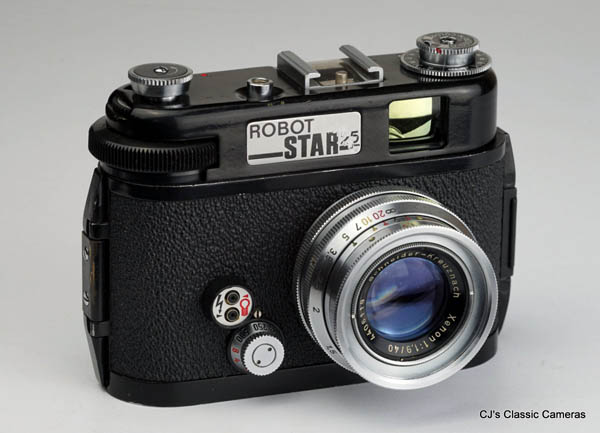
Black version of Berning Robot Star 25 with Xenon lens. There are more modern styled black Xenar and Xenon lenses around that would fit this camera very nicely, but they're quite rare and thus expensive. I am not quite sure which version of the lens thie camera came with originally, as the older version is more commonly found.
Berning Robot Royal 36
The Robot Royal range represented a significant redesign of the earlier Robots and was first introduced around 1953. The Royals were considerable larger and heavier than their predecessors, as they were rangefinder cameras designed to be able to use the full frame 36x24mm format, although the first version still used the regular square format like the earlier Robots. The Royal 36 was an improved version of the original Royal and was introduced alongside the square format Royal 24 and the (extremely rare) half-frame Royal 18, the number indicating the frame width in mm.
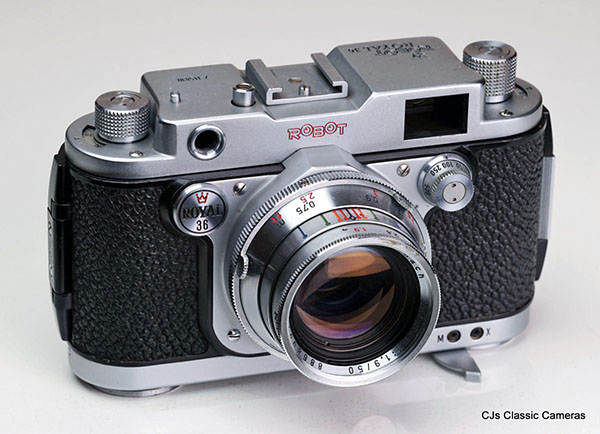
Robot Royal 36 with Schneider 50mm f/1.9 Xenon lens. Because of the different frame sizes of the different Royals, one has to take care which lens the camera comes with. For example, the Royal 24 came with a 40mm Xenon lens, but I am not sure if it would cover the full 36mm frame (see more on this below).
Another important difference with previous Robot models was the Royal lens mount, which was a bayonet mount, the lens being secured by twisting a large lever at the bottom of the mount. I have grabbed this lever several times thinking it was the focus lever, but thankfully it does not twist easily as otherwise the lens would have been on the floor! Like the previous models, the Royal could use regular film cassettes, but still needed a dedicated take-up cassette, the NR. The spring motor allowed up to 24 shots to be taken consecutively without have to wind the camera.

Top view of the Robot Royal 36. Note the colour-coded depth of field markings on the lens, a typical Robot feature already present on the Robot I.

Rear view of the Robot Royal 36 showing the 36x24mm film frame. Also note the small lever beneath the accessory shoe, which was to lock the shutter (red dot) or to rewind film (R). Moving the lever would also block the view through the viewfinder to warn the user the shutter was locked or set to rewind. Rewinding was only necessary when using a regular film cassette, not when using the Robot TR cassette.
A limited range of interchangeable lenses was available for the Robot Royal range, and because the different models have different frame sizes, knowing which lens to fit which camera can be a little confusing. In fact, I got it wrong myself. The standard lens for the Royal 24 is 40mm Xenon or 38mm Xenar, whereas that for the Royal 36 is 50 mm Sonnar or Xenon, or 45mm Xenar. As a wide angle lens, for the Royal 24 there was the Xenagon 30mm f/3.5, whereas for the Royal 36 there was the 35mm Xenogon f/2.8. So I figured the same difference in focal length would apply to telelenses, of which there are two: a 75mm Tele-Xenar and a 90mm Tele-Arton, and the latter one would be for the Royal 36. This is in fact incorrect! The 75mm is for the Royal 36, the 90 mm for the Royal 24. I learned this the hard way, as Royal 36 lenses have two notches on their lens base, fitting with two tabs on the lens mount. The Royal 24 mount has only one such notch. This means that all Royal 36 lenses will fit on the Royal 24, but not the other way round (to avoid vignetting on the larger Royal 36 film frame). Perhaps Robot received complaints about this, as on late production of the Royal 36 there is only one tab, just like on the Royal 24, so all lenses will fit.
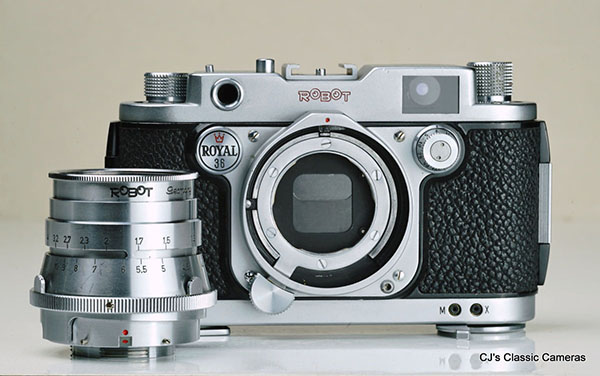
Frontal view of the Robot Royal 36 mount, with two small tabs visible on the outer ring of the mount at 12 and 9 o'clock positions. Or rather, the 9 o'clock one has been removed to fit the 90mm Tele-Arton, which has only one notch (visible with red dots on the lens mount).
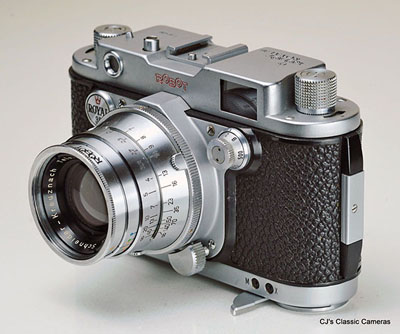
| | So the Schneider 90mm f/4 Tele-Arton can be fitted to the Royal 36 after removing the second tab on the lens mount. However, the lens is seated incorrectly, it is rotated by 90 degrees so the focus marks are not where they should be. Thankfully, the rangefinder coupling does appear to be correct.
|
Robot Recorder 36M
In the 1960s and 1970s Robot increasingly moved to making specialty cameras for industrial, scientific and surveillance use, for which purposes the Robot Recorder was introduced. This was essentially a Robot Royal without viewfinder or film rewind, but usually with an electric motor drive. Many different variants exists depending on designated use, such a traffic surveillance, scientific or medical applications, etc., and had add-ons such as remote electronic shutter release and large-volume film magazines.
The Robot company became more and more specialised, leaving the consumer market behind completely, and produced cameras until well into the 1990s, after which it was amalgamated in the Jenoptik group, to which the weblink robot.de now refers.
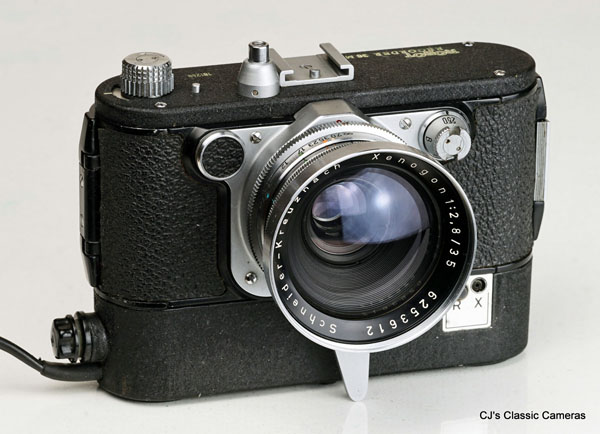
Robot Recorder 36M with Schneider 35 mm f/2.8 Xenogon lens wide angle lens, which is the real reason I bought this camera, as it is a beautiful lens which is rangefinder coupled and can be used on the Robot Royal. It was rather unusual to find this lens on a Recorder, which are more commonly found with normal or telelenses. The Recorder 36M has a 24V electric motor drive, which still works perfectly.
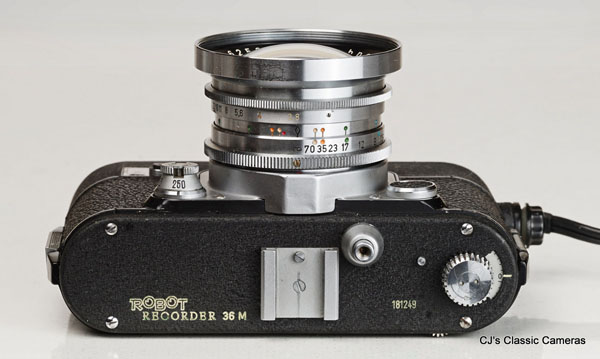
Top view of the Robot Recorder 36M, also showing on the lens the typical Robot colour coding of depth of field and hyperfocal distances at various apertures, already present on the lens of the first Robot on this page!
|

